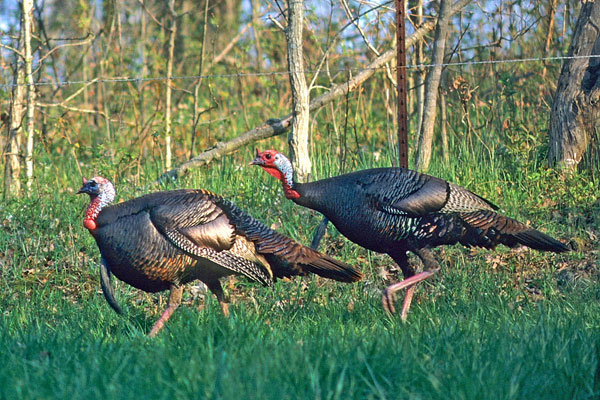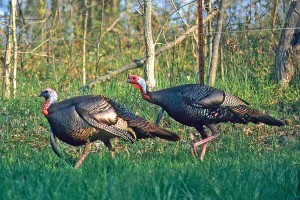
Kentucky Afield Outdoors:
Feb. 24, 2011 Author Art Lander Jr.
FOR IMMEDIATE RELEASE 1-800-858-1549, ext. 4414
Contact: Art Lander, Jr.
FRANKFORT, Ky. – With Kentucky’s spring wild turkey season opening in less than two months, now is a good time to make sure your shotgun is on target.
Sighting-in is especially important if you will be hunting with a shotgun you are unfamiliar with, or you’ve changed your shotgun’s barrel choke or hunting load.
One key difference between turkey hunting and other upland game bird hunting is the shotgun, and how it performs.

The turkey shotgun is carefully aimed like a rifle and must be able to deliver a tight swarm of hard-hitting pellets to a relatively small target. A turkey’s vital area is its head and neck, which is about the size of an adult’s clenched fist, wrist and forearm. Even the largest of gobblers will be instantly immobilized if shot pellets penetrate its bony skull or vertebrae.
The sight-in process should answer three important questions about your turkey shotgun:
1) Does the shotgun shoot where it’s aimed?
2) Can the shotgun deliver a tight pattern of pellets at a reasonable distance?
3) What’s the maximum effective range of the shotgun?
It’s surprising how many shotgun barrels aren’t straight, and as a result they throw shot patterns that may imprint high, low, left or right of the aiming point. The problem can also be traced to improperly installed choke tubes.
“If the choke tubes aren’t parallel to the bore, the point of impact will be off,” said Mike Ezell, a gunsmith in Auburn, Ky. “I can also make a barrel adjustment, in which the barrel is actually bent (straightened) with the use of a jig.”
One way to check a shotgun’s point of impact is to shoot at a paper target at close range from a steady rest.
Chamber a low-powered target load (No. 6 or No. 7 1/2 shot) and shoot at a baseball-sized bullseye at about eight yards. In just one shot you’ll be able to see if the shot pattern is centered on the bullseye.
The most economical way to correct a point of impact problem is to install moveable open sights on your shotgun’s barrel. Several companies make fiber-optic sights that simply wrap around a shotgun’s barrel or attach to its ventilated rib. Changes in windage and elevation, to center the pattern on the bullseye, are made with just a few turns of a screwdriver.
Another option is to replace a crooked barrel. Most brands of shotguns offer replacement barrels especially made for turkey hunting. They are typically shorter (20 to 24 inches) and may be equipped with sights and screw-in choke tubes. Hunters who need the advantage of better vision in low light or heavy cover might also consider installing a telescopic sight on their turkey shotgun. The increased magnification makes sighting-in faster and easier.
Once your shotgun’s point of impact problem is solved, the next step is pattern density testing — to find the best load for your shotgun. This will involve shooting several brands of turkey loads, with different shot sizes, at a turkey head target.
“You get just one shot at a turkey, so you’ve got to make it count,” said Peter Garrett, a gunsmith in Newport, Ky. “I recommend smaller shot for better (more uniform) patterns.”
Another procedure a gunsmith can perform that will improve your shotgun’s patterning ability is lengthening the barrel’s forcing cone.
“This creates a more even transition after the shotshell opens up, and the shot string moves down the barrel,” said Garrett.
There’s been a quantum leap in turkey gun performance in the past decade. Today’s off-the-shelf, high-performance turkey shotguns are capable of putting more than 100 No. 6 pellets into a 10-inch circle at 40 yards. Most turkeys are bagged at much closer ranges, so a high performance turkey gun isn’t necessary to be a successful hunter.
Two popular chokes for 12-gauge shotguns used in turkey hunting are full (diameter .694), and extra full (diameter .689), but after-market chokes are available in much tighter constrictions, such as .675 or .670.
The most effective shot sizes for turkeys are No. 4, No. 5 and No. 6. Both lead and non-toxic shot are legal, but shot larger than No. 4 may not be used to hunt turkeys in Kentucky.
Generally, the smaller No. 6 shot requires a tighter choke for best results. When shooting larger shot, such as No. 4, loosen up the choke constriction, and you’ll get more uniform patterns.
“The heavier payloads of shot in a shell (1 7/8-ounce or 2 ounces of shot) tend to blow holes in patterns if the choke is too tight,” said Ezell. “For more consistent patterns, you’ve got to back off on the choke constriction.”
There’s also a trade-off with changes in shot size – the larger the pellet, the fewer per ounce. For example, one ounce of lead shot is equal to: 135 No. 4s, 170 No. 5s or 225 No. 6s. Smaller shot carries less energy downrange, but creates denser patterns. Larger shot carries more energy downrange, but shoots much less dense patterns.
What’s a reasonable hunting distance for turkeys? Lots of gobblers are taken each spring under 30 yards, so don’t get discouraged if your shotgun won’t throw tight patterns farther out than that. Keep testing load and choke combinations until you find what works best.
Since turkey hunting shotshells are expensive, a good way to offset the cost is to buy several boxes of shells as a group, sharing among hunting buddies or club members. That way everyone gets to try several different brands to see what shoots best in their gun.
Once you’ve found the shot size and choke combination that yields the tightest, most uniform patterns, it’s simply a matter of shooting at increasingly farther distances to determine your shotgun’s effective range.
When the number of pellets in the turkey’s vital area on the target drops below 15 you’ve reached the outer limits of your shotgun’s effectiveness. Never shoot beyond that distance and you’ll be confident that your shotgun will do its job when the time comes.
“Every gun is different,” said Ezell, “but I recommend trying some of the heavier-than-lead shot that’s on the market today. It will improve your patterns and penetration.”
Made from metal alloys, non-toxic shot has become increasingly popular with turkey hunters because it exhibits superior patterning — tighter groups at longer ranges.
Use these tips to put more turkeys in your bag this spring.
Author Art Lander Jr. has been writing about the outdoors since the 1970s. He is a staff writer for Kentucky Afield Magazine.
-30-
The Kentucky Department of Fish and Wildlife Resources manages, regulates, enforces and promotes responsible use of all fish and wildlife species, their habitats, public wildlife areas and waterways for the benefit of those resources and for public enjoyment. Kentucky Fish and Wildlife is an agency of the Tourism, Arts and Heritage Cabinet. For more information on the department, visit our website at fw.ky.gov.


I live in southern California where turkey is a tough hunt and scarce. I have been taking my boys for 6 years and although we have seen turkey, we have never had one close enough to bag.
This article has been very helpful.
Thank you